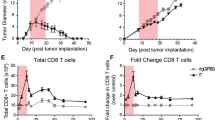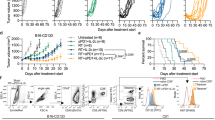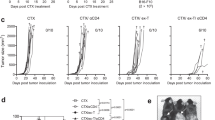Abstract
Adoptive T cell therapy for cancer patients optimally requires participation of CD4 T cells. In this phase I/II study, we assessed the therapeutic effects of adoptively transferred IL-10- and IFN-γ-producing CD4 effector cells in patients with recurrent ovarian cancer. Using MUC1 peptide and IL-2 for ex vivo CD4 effector cell generation, we show that three monthly treatment cycles of autologous T cell restimulation and local intraperitoneal re-infusion-modulated T cell-mediated immune responses that were associated with enhanced patient survival. One patient remains disease-free, another patient experienced prolonged survival for nearly 16 months with recurrent disease, and two patients expired within 3–5 months following final infusion. Prolonged survivors showed elevated levels of systemic CD3+CD4+CD25+ and CD3+CD4+CD25− T cells when compared to that of pre-treatment levels and similarly treated short-term survivors. Such cell populations among these patients contained variable levels of “Inducible” Tr1 (CD4+CD25−FoxP3−IL-10+) and “Natural” (CD4+CD25+CD45RO+FoxP3+) TReg cell numbers and ratios that were associated with prolonged and/or disease-free survival. Moreover, peptide-restimulated T cells from these patients showed an elevation in both IFN-γ production, memory cell phenotype, and select TNF family ligands associated with enhanced T cell survival and apoptosis-inducing activities. This suggests that intraperitoneally administered Th1-like cells, producing elevated levels of IL-10, may require and/or induce differential levels of distinct systemic TReg subpopulations that influence, in part, long-term tumor immunity and enhanced memory/effector CD4-mediated therapeutic potentials. Furthermore, treatment efficacy and enhanced memory cell phenotype did not appear to be dependent on TReg cell numbers but upon ratios of “Inducible” and “Natural” TReg subpopulations.







Similar content being viewed by others
Abbreviations
- Th1:
-
CD4+ T cells producing IFN-γ
- TReg:
-
Regulatory T cells
- Foxp3:
-
Forkhead box protein p3
- TR1:
-
CD4+ CD25−FoxP3− T cells producing IL-10
- nTRegs:
-
Ag-experienced natural TReg CD4+CD25+CD45RO+FoxP3− cells
References
Jemel A, Siegel R, Ward E, Hao Y, Xu J, Thun MJ (2009) Cancer statistics. CA Cancer J Clin 59:225–249
Yap T, Carden CP, Kaye SB (2009) Beyond chemotherapy: targeted therapies in ovarian cancer. Nat Rev Cancer 9:167–181
Nelson BH (2008) The impact of T cell immunity on ovarian cancer outcomes. Immunol Rev 222:101–116
Muranski P, Restifo NP (2009) Adoptive immunotherapy of cancer using CD4+ T cells. Curr Opin Immunol 21:200–208
O’Garra A, Vieira P (2007) Th1 cells control themselves by producing IL-10. Nat Rev Immunol 7:425–428
Trinchieri G (2007) IL-10 production by effector T cells: Th1 cells show self control. J Exp Med 204:239–243
Jankovic D, Kugler DG, Sher A (2010) IL-10 production by CD4 effector T cells: a mechanism for self regulation. Mucosal Immunol 3:239–246
Haringer B, Lozza L, Steckel B, Geginat J (2009) Identification and characterization of IL-10/IFN-γ-producing effector-like T cells with regulatory function in human blood. J Exp Med 206:1009–1017
Gerosa F, Nisii C, Righetti S, Micciolo R, Marchesini M, Cazzadori A, Trinchieri G (1999) CD4 T cell clones producing both IFN-γ and IL-10 predominate in bronchoalveolar lavages of active pulmonary tuberculosis patients. Clin Immunol 92:224–234
Assudani DP, Horton RBV, Mathieu MG, McArdle SEB, Rees RC (2007) The role of CD4+ T cell help in cancer immunity and the formation of novel cancer vaccines. Cancer Immunol Immunther 56:70–80
Kennedy R, Celis E (2008) Multiple roles of CD4 T cells in antitumor responses. Immunological Revs 222:129–144
Newsbeth YC, Martinez DG, Toraya S, Scarlett UK, Cubillos-Ruiz JR, Rutkowski MR, Conejo-Garcia JR (2010) CD4 T cells elicit host immune responses to MHC Class II-ovarian cancer through CCL5 secretion and CD40 mediated licensing of dendritic cells. J Immunol 184:5654–5662
Perez-Diez A, Joncker NT, Choi K, Chan WFN, Anderson CC, Lantz O, Matzinger P (2007) CD4 cells can be more efficient at tumor rejection than CD8 cells. Blood 109:5346–5354
Moeller M, Haynes NM, Kershaw MH, Jackson JT, Teng MWL, Street SE, Cerutti L, Jane SM, Trapani JA, Smyth MJ, Darcy PK (2005) Adoptive transfer of gene-engineered CD4 helper T cells induce potent primary and secondary tumor rejection. Blood 106:2995–3003
Liu Z, Noe HS, Chen J, Kim JH, Falo LD Jr, You Z (2008) Potent tumor-specific protection ignited by adoptively transferred CD4 T cells. J Immunol 181:4363–4370
Nesbeth Y, Conejo-Garcia JR (2010) Harnessing the effects of adoptively transferred tumor-reactive T cells on endogenous antitumor responses. Clinical Developmental Immunol. doi:10.155/2010/13904
Hunder NN, Wallen H, Cao J, Hendricks DW, Reilly JZ, Rodmyre R, Jungbluth A, Gnjatic S, Thompson JA, Yee C (2008) Treatment of metastatic melanoma with autologous CD4 T cells against NY-ESO-1. N Eng J Med 358:2698–2703
Nishikawa H, Sakaguchi S (2010) Regulatory T cells in tumor immunity. Int J Cancer 127:759–767
Sakaguchi S, Miyara M, Costantino CM, Hafler DA (2010) FOXP3+ regulatory T cells in the human immune system. Nat Revs Immunol 10:490–500
Sakaguchi S (2008) Regulatory T cells and immune tolerance. Cell 133:775–787
Riley JL, June CH, Blazer BR (2009) Human T regulatory cell therapy: take a billion or so and call me in the morning. Immunity 30:656–665
Buckner JH (2010) Mechanisms of impaired regulation by CD4+CD25+FOXP3+ regulatory T cells in human autoimmune disease. Nat Rev Immunol 10:849–859
Shevach EM (2009) Mechanisms of Foxp3+ T regulatory cell-mediated suppression. Immunity 30:636–645
Miyara M, Sakaguchi S (2011) Human FoxP3+CD4+ regulatory T cells: their knowns and unknowns. Immunol Cell Biol 89:346–351
Grazia Roncarolo M, Gregori S, Battaglia M, Bacchetta R, Fleischhauer K, Levings MK (2006) IL-10-secreting type 1 regulatory T cells in rodents and humans. Immunol Rev 212:28–50
Groux H, O’Garra A, Bigler M, Rouleau M, Antonenko S, de Vries JE, Roncarolo MG (1997) A CD4+ T cell subset inhibits antigen-specific T cell responses and prevents colitis. Nature 389:737–742
O’Garra A, Vieira PL, Vieira P, Goldfeld AE (2004) IL-10 producing and naturally occurring CD4 Tregs: limiting collateral damage. J Clin Invest 114:1372–1378
Zou W (2006) Regulatory T cells, tumor immunity and immunotherapy. Nat Rev Immunol 6:295–307
Curiel TJ, Coukos G, Zou L, Alvarez X, Cheng P, Mottram P, Evdemon-Hogan M, Conejo-Garcia JR, Zhang L, Burrow M, Zhu Y, Wei S, Kryczek I, Daniel B, Gordon A, Myers L, Luckner A, Disis ML, Knutson KL, Chen W, Zou W (2004) Specific recruitment of regulatory T cells in ovarian carcinoma fosters immune privilege and predicts reduced survival. Nat Med 10:942–949
Wolf D, Wolf AM, Rumpold H, Fiegl H, Zeimet AG, Muller-Holzner E, Deibl M, Gastl G, Gunsilius E, Marth C (2005) The expression of the regulatory T Cell–specific forkhead box transcription factor FoxP3 is associated with poor prognosis in ovarian cancer. Clin Cancer Res 11:5380–8326
Woo EY, Chu CS, Goletz TJ, Schlienger K, Yeh H, Coukos G, Rubin SC, Kaiser LR, June CH (2001) CD4/CD25 + T cells in tumors from patients with early-stage non-small lung cancer and late stage ovarian cancer. Can Res 61:4766–4772
Dobrzanski MJ, Rewers-Felkins KA, Abdul Samad K, Quinlin IS, Robinson W, Dobrzanski DJ, Wright SE (2009) Autologous MUC1-specific Th1 effector cell immunotherapy induces differential levels of systemic TReg cell populations that result in increased ovarian cancer patient survival. Clin Immunol 133:333–352
Wright SE, Rewers-Felkins KA, Quinlin IS, Eldridge PW, Zorsky PE, Klug P, Phillips CA (2002) Adoptive immunotherapy of mucin1 expressing adenocarcinomas with mucin1 stimulated human peripheral blood mononuclear cells. Int J Mol Med 9:401–404
Wright SE, Khaznadar R, Wang Z, Quinlin IS, Rewers-Felkins KA, Phillips CA, Patel S (2008) Generation of MUC1-stimulated mononuclear cells using optimized conditions. Scand J Immunol 67:24–29
Hiltbold EM, Ciborowski P, Finn OJ (1998) Naturally processed class II epitope from the tumor antigen MUC1 primes human CD4 T cells. Can Res 58:5066–5070
Dobrzanski MJ, Reome JB, Hylind JC, Rewers-Felkins KL (2006) CD8-mediated type 1 antitumor responses selectively modulate endogenous differentiated and non-differentiated T cell localization, activation and function in progressive breast cancer. J Immunol 177:8191–8201
Croft M (2009) The role of TNF superfamily members in T cell function and diseases. Nat Rev Immunol 9:271–285
O’Garra A, Barrat RJ, Castro AG, Vicari A, Hawrylowicz C (2008) Strategies for use of IL-10 or its antagonists in human disease. Immunol Rev 223:114–131
Saraiva M, O’Garra A (2010) The regulation of IL-10 production by immune cells. Nat Rev Immunol 10:170–181
Murai M, Turovskaya O, Kim G, Madan R, Karp CL, Cheroutre H, Kronenberg M (2009) IL-10 acts on regulatory T cells to maintain expression of the transcription factor FoxP3 and suppress function in mice with colitis. Nat Immunol 10:1178–1184
Pierson W, Liston A (2010) A new role for IL-10 in immune regulation. Immunol Cell Biol 88:769–770
Jarnicki AG, Lysaght J, Todryk S, Mills KHG (2006) Suppression of antitumor immunity by IL-10 and TGF-β -producing T cells infiltrating the growing tumor: influence of tumor environment on the induction of CD4+ and CD8+ regulatory T cells. J Immunol 177:896–904
Tilg H, van Montfrans C, van den Ende A, Kaser A, van Deventer SJ, Schreiber S, Gregor M, Ludwiczek O, Rutgeerts P, Gasche C, Koningsberger JC, Abreu L, Kuhn I, Cohard M, LeBeaut A, Grint P, Weiss G (2002) Treatment of Crohn’s disease with recombinant human IL-10 induces the proinflamatory cytokine IFN-γ. Gut 50:191–195
Lauw FN, Pajkrt D, Hack CE, Kurimoto M, van Deventer SJ, van der Poll T (2000) Proinflammatory effects of IL-10 during human endotoxemia. J Immunol 165:2783–2789
Chen WF, Zlotnik A (1991) IL-10: a novel cytotoxic T cell differentiation factor. J Immunol 147:528–534
Groux H, Bigler M, de Vries JE, Roncarolo MG (1998) Inhibitory and stimulatory effects of IL-10 on human CD8 T cells. J Immunol 160:3188–3193
Mocellin S, Marincola FM, Young HA (2005) Interleukin-10 and the immune response against cancer: a counterpoint. J Leukoc Biol 78:1043–1051
Zheng LM, Ojcius DM, Garaud F, Roth C, Maxwell E, Li Z, Rong H, Chen J, Wang XY, Catino JJ, King I (1996) IL-10 inhibits tumor metastasis through an NK cell-dependent mechanism. J Exp Med 184:579–584
Berman RM, Suzuki T, Tahara H, Robbins PD, Narula SK, Lotze MT (1996) Systemic administration of cellular IL-10 induces an effective specific and long lived immune response against established tumors in mice. J Immunol 157:231–238
Fujii S, Shimizu K, Shimizu T, Lotze MT (2001) IL-10 promotes the maintenance of antitumor CD8 T effector cell function in situ. Blood 98:2143–2151
Dobrzanski MJ, Reome JB, Hylind JC, Rewers-Felkins KA, Abdulsamad K, Adams SL (2008) Ag-specific type 1 CD8 effector cells enhance methotrexate-mediated antitumor responses by modulating endogenous CD49b-expressing CD4 and CD8 T effector cell subpopulations producing IL-10. Immunol Invest 37:315–338
Jones M, Ladell K, Wynn KK, Stacey MA, Quiqley MF, Gostick E, Price DA, Humphreys IR (2010) IL-10 restricts memory T cell inflation during cytomegalovirus infection. J Immunol 185:3583–3592
Kang SS, Allen PM (2005) Priming in the presence of IL-10 results in direct enhancement of CD8 T cell primary responses and inhibition of secondary responses. J Immunol 174:5382–5389
Foulds KE, Rotte MJ, Seder RA (2006) IL-10 is required for optimal CD8 T cell memory following Listeria monocytogenes infection. J Immunol 177:2565–2574
Dunn GP, Koebel CM, Schreiber RD (2006) Interferons, immunity and cancer immunoediting. Nat Rev Immunol 6:836–848
Nishikawa H, Kato T, Tawara I, Ikeda H, Kuribayashi K, Allen PM, Schreiber RD, Old LJ, Shihu H (2005) IFN-γ controls the generation/activation of CD4+CD25+ regulatory T cells in antitumor immune response. J Immunol 175:4433–4440
Wang Z, Hong J, Sun W, Xu G, Li N, Chen X, Liu A, Xu L, Sun B, Zhang JZ (2006) Role of IFN-γ in induction of Foxp3 and conversion of CD4+CD25− T cells to CD4+ Tregs. J Clin Invest 116:2434–2441
Cao X, Leonard K, Collins LI, Cai SF, Mayer JC, Peyton JE, Walter MJ, Piwnica-Worms D, Schreiber RD, Ley TJ (2009) IL-12 stimulates IFN-g-mediated inhibition of tumor-induced regulatory T cell proliferation and enhances tumor clearance. Can Res 69:8700–8709
Vukmanovic-Stejic M, Zhang Y, Cook JE, Fletcher JM, McQuaid A, Masters JE, Rustin MHA, Taams LS, Beverley PCL, Macallan DC, Akbar AN (2006) Human CD4+CD25HIFoxp3+ regulatory T cells are derived by rapid turnover of memory populations in vivo. J Clin Invest 116:2423–2433
Komatsu N, Mariotti-Ferrandiz ME, Wang Y, Malissen B, Waldmann H, Hori S (2009) Heterogeneity of natural FoxP3 T cells: a committed regulatory T cell lineage and an uncommitted minor population retaining plasticity. PNAS 106:1903–1908
Hendriks J, Gravestein LA, Tesselaar K, van Lier RA, Schumacher TN, Borst J (2000) CD27 is required for generation and long-term maintenance of T cell immunity. Nat Immunol 1:433–440
Hendriks J, Xiao Y, Borst J (2003) CD27 promotes survival of activated T cells and complements CD28 in generation and establishment of the effector T cell pool. J Exp Med 198:1369–1380
Ramon-Arens R, Schepers K, Nolte MA, van Oosterwijk MF, van Lier RAW, Schumacher TNM, van Oers MHJ (2004) Tumor rejection induced by CD70-mediated quantitative and qualitative effects on effector CD8 T cell formation. J Exp Med 199:1595–1605
Valzasina B, Guiducci C, Dislich H, Killeen N, Weinberg AD, Colombo MP (2005) Triggering of OX-40 (CD134) and CD4 + CD25 + T cells block their inhibitory activity: a novel regulatory role for OX40 and its comparison with GITR. Blood 105:2845–2851
Piconese S, Valzasina B, Colombo MP (2008) OX40 triggering blocks suppression by regulatory T cells and facilitates tumor rejection. J Exp Med 205:825–839
Morel Y, Truneh A, Costello RT, Olive D (2003) LIGHT, a new TNF superfamily member, is essential for memory T helper cell-mediated activation of dendritic cells. Eur J Immunol 33:3213–3219
Morel Y, Truneh A, Sweet RW, Olive D, Costello RT (2001) The TNF superfamily members LIGHT and CD154 (CD40 Ligand) costimulate induction of dendritic cell maturation and elicit specific CTL activity. J Immunol 167:2479–2486
Huang J, Kerstann KW, Ahmadzadeh M, Li YF, El-Gamil M, Rosenberg SA, Robbins PF (2006) Modulation by IL-2 of CD70 and CD27 expression on CD8 T cells: importanance for the therapeutic effectiveness of cell transfer immunotherapy. J Immunol 176:7726–7735
Moira Wilke C, Wu K, Zhao E, Wang G, Zou W (2010) Prognostic significance of regulatory T cells in tumor. Int J Cancer 127:748–758
Tosolini M, Kirilovsky A, Mlecnik B, Fredriksen T, Mauger S, Bindea G, Berger A, Bruneval P, Fridman W, Pages F, Galon J (2011) Clinical impact of different classes of infiltrating T cytotoxic and helper cells in patients with colorectal cancer. Can Res 71:1263–1271
Wolf AM, Wolf D, Steurer M, Gastl G, Gunsilius E, Grubek-Loebenstein B (2003) Increase in regulatory T cells in the peripheral blood of cancer patients. Clin Cancer Res 9:606–612
Li X, Ye D, Xie X, Chen H, Lu W (2005) Proportions of CD4 + CD25 + regulatory T cells is increased in patients with ovarian cancer. Cancer Invest 23:399–403
Merlo A, Casalini P, Carcangui ML, Malventano C, Triulzi T, Menard S, Tagliabue E, Balsari A (2009) FoxP3 expression and overall survival in breast cancer. J Clin Oncol 27:1746–1752
Loddenkemper C, Schernus M, Noutsias M, Stein H, Thiel E, Nagorsen D (2006) In situ analysis of FoxP3 regulatory T cells in human colorectal cancer. J Transl Med 4:52–59
Salama P, Phillips M, Grieu F, Morris M, Zeps N, Joseph D, Platell C, Iacopetta B (2009) Tumor infiltrating FoxP3 + T regulatory cells show strong prognostic significance in colorectal cancer. J Clin Oncol 27:186–192
Erdman SE, Sohn JJ, Roa VP, Nambiar PR, Ge Z, Fox JG, Schauer DB (2005) CD4 + CD25 + regulatory lymphocytes induce regression of intestinal tumors in ApcMin/+ mice. Can Res Priority Report 65:3998–4004
Grivennikov SL, Greten FR, Karin M (2010) Immunity, inflammation and cancer. Cell 140:883–899
Dudley ME, Yang JC, Sherry R, Hughes MS, Royal R, Kammula U, Robbins PF, Huang J, Citrin DE, Leitman SF, Wunderlich J, Restifo NP, Thomasian A, Downey SG, Smith FO, Klapper J, Morton K, Laurencot C, White DE, Rosenberg SA (2008) Adoptive cell therapy for patients with metastatic melanoma: evaluation of intense myeloablative chemoradiation preparative regimens. J Clin Oncol 26:5233–5239
Berger C, Turtle CJ, Jensen MC, Riddell SR (2009) Adoptive transfer of virus-specific and tumor specific T cell immunity. Curr Opin Immunol 21:224–232
Acknowledgments
The authors are grateful to those mentioned in the text for supplying materials, Coffee Memorial Blood Bank, Amarillo, TX, under the direction of Mary Townsend, for leukaphereses. Robin McWherter and Beth Vertin for technical assistance and the Clinical Trials Department of the Harrington Cancer Center, Amarillo, TX, for data collection. This work was supported by grants through the Harrington Cancer Research Foundation, Amarillo, TX (to M.J.D.), Department of Veterans Affairs Medical Research Program (to S.E.W.), Institutional Research Program of the Texas Tech School of Medicine (to M.J.D.), National Institutes of Health Grant 1R21CA89883-01A1 (to W.R. and S.E.W), Department of Defense Medical Research Development Command DAMD 17-01-1-0429 (to M.J.D.) and the Don & Sybil Harrington Foundation, Amarillo, TX (to S.E.W. and C.A.P.).
Conflict of interest
None of the authors have any potential financial conflict of interest related to this manuscript.
Author information
Authors and Affiliations
Corresponding authors
Rights and permissions
About this article
Cite this article
Dobrzanski, M.J., Rewers-Felkins, K.A., Samad, K.A. et al. Immunotherapy with IL-10- and IFN-γ-producing CD4 effector cells modulate “Natural” and “Inducible” CD4 TReg cell subpopulation levels: observations in four cases of patients with ovarian cancer. Cancer Immunol Immunother 61, 839–854 (2012). https://doi.org/10.1007/s00262-011-1128-x
Received:
Accepted:
Published:
Issue Date:
DOI: https://doi.org/10.1007/s00262-011-1128-x




